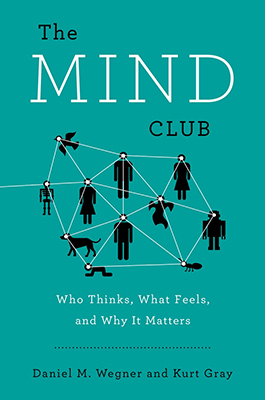It seems obvious that most people have minds, at least our spouses, friends and family, but what about animals, machines, vegetative patients, the dead and God? The mental capacities of these “cryptominds” are uncertain, and therefore a matter of perception. Take dogs, for example. If you own a dog, you likely see it as having a rich mental life, whereas your neighbor might see only a biological system for converting kibble into poop. When the owner of a pet, or the relative of a coma patient, or the inventor of a robot, perceives the capacity for thinking and feeling, then that entity joins the “mind club.”
Membership in this club is extremely important, because entities with minds enjoy moral status, whereas entities without minds are merely “things” to be bought and sold. Supporters of slavery justified themselves by denying human minds to African-Americans, seeing these people as mentally equivalent to livestock. In a large scale study, lab research has revealed that judgments of both moral rights and moral responsibility hinge upon perceptions of mind.
 Dr. Kurt Gray’s Mind Perception and Morality (MPM) lab studies the role of mind perception in political conflict. Dr. Gray and his team have discovered that, despite disagreement about the morality of taxation, gun control, and abortion, liberals and conservatives all agree that morality is about limiting suffering to other minds. Consider the case of gay marriage – although this act may seem objectively harmless to many liberals, Dr. Gray revealed that conservatives indelibly link this act to harm, explaining their intensity of moral opposition. These studies casts doubt on the notion of “harmless wrongs,” because people inevitably see harm where they see immorality. Dr. Gray elaborates more about harmless wrong in his article, “The Myth of the Harmless Wrong,” published in The New York Times.
Dr. Kurt Gray’s Mind Perception and Morality (MPM) lab studies the role of mind perception in political conflict. Dr. Gray and his team have discovered that, despite disagreement about the morality of taxation, gun control, and abortion, liberals and conservatives all agree that morality is about limiting suffering to other minds. Consider the case of gay marriage – although this act may seem objectively harmless to many liberals, Dr. Gray revealed that conservatives indelibly link this act to harm, explaining their intensity of moral opposition. These studies casts doubt on the notion of “harmless wrongs,” because people inevitably see harm where they see immorality. Dr. Gray elaborates more about harmless wrong in his article, “The Myth of the Harmless Wrong,” published in The New York Times.
In further attempting to explain how these difference in morality and mind perception develop, lab research has investigated the genesis of social groups. Using computer models, Dr. Gray has found that social groups form robustly even without different identities (e.g., race or religion). Instead, people cluster together based upon chance interactions and reinforce these clusters based on gossip. Dr. Gray says his studies indicate that reciprocity and transitivity govern the formation of groups in social interaction – two factions that together create a powerful sense of ‘us’ and ‘them.’ Read more about the formation of groups and human interaction in “Groups Fundamental to Human Psychology” in the Yale Daily News. Dr. Gray’s lab research investigates the deeper causes of moral and intergroup conflict.
 Dr. Kurt Gray is an Assistant Professor in Social Psychology. He investigates the mysterious inner lives of animals, machines, and human beings. His book, “The Mind Club: Who Thinks, What Feels, and Why It Matters,” explores the moral dimensions of mind perception, revealing the surprisingly simple basis for what compels us to love and hate, to harm and to protect. “The Mind Club” will be published March 2016 and is available via Amazon to pre-order.
Dr. Kurt Gray is an Assistant Professor in Social Psychology. He investigates the mysterious inner lives of animals, machines, and human beings. His book, “The Mind Club: Who Thinks, What Feels, and Why It Matters,” explores the moral dimensions of mind perception, revealing the surprisingly simple basis for what compels us to love and hate, to harm and to protect. “The Mind Club” will be published March 2016 and is available via Amazon to pre-order.

